My Setup
I’m changing my setup all the time depending on my whims, or trying to make the setup more efficient. I keep trying things and I’m doing something with the mealworms or beetles daily, so it’s always getting tweaked. This is my setup as of March, 2021.
At this time I have a large quantity of second generation mealworms, the first batch born in this house, and I’m just starting to have my third generation pupating but no beetles yet. Because the third generation is maturing and old beetles don’t produce top quality offspring (old beetles produce fewer and smaller offspring, and a higher rate of deformities, per some study I’ll have to find again and cite here eventually), I fed the last of my first generation of darkling beetles to my chickens recently.
Most people mix their beetle generations, some people sort them out by age so they can more easily dispose of older ones, but I kind of like knowing what generation a mealworm/beetle is, so I’m doing my best to keep them separate.
Mealworm Storage
I have my main mealworms sorted by size in a 9-drawer tower I bought on Amazon for $40.
- The top drawers are all my second generation mealworms, sorted by size, largest on top. When the ones at the top start pupating I try to separate out sellable ones and refrigerate them for upcoming sales. I put any that are clearly near pupation in the Not-For-Sale bin to complete pupation without the chance of being sold anywhere. I “size up” each bin using my sifters about once every two weeks.
- Under those I have one drawer so far dedicated to Gen 3.
- Under that I have my “Not-For-Sale” bin which I feed just about anything because they’re either becoming beetles and aren’t going to be fed to anything any time soon, or they’re going straight to my personal chickens.
- Lastly I have two drawers dedicated to supplies (mostly little portion cups and lids) but I may have to reclaim those for mealworms soon as gen 3 gets going.
In addition to that tower, I have varying quantities of nursery bins. Currently I have two Gen 3 nursery bins, and my last Gen 2 nursery bin.

Feeding
While I will feed my Not-For-Sale mealworms just about anything, including styrofoam (mealworms are one of the only things that can digest that safely!) the rest of my mealworms are fed a bit stricter and live on a bedding made primarily of wheat bran along with other bread products and dried veggies/fruits, and are fed primarily fermented chick starter as their food-water source plus the occasional spray from a water bottle which wets just the top layer of bedding to make it appetizing and ensure more mealworms have a chance at a water source. They also get occasional veggie/fruit/bread kitchen scraps when we have some. For example, I made potatoes for dinner the other day and all the bins got a handful of the peels.
Pupae
I pull pupae out of my bins once or twice every week. I sort the pupae by size, giving the smallest to my chickens as snacks.
At this moment (2021-03-04) I am only keeping pupae which are .11g or larger, and have a special bin for any that are .17g or larger (.2+ g is huge!). I am also only keeping G3 pupae which are .15g or larger which so far has been a good portion of them; gen 3 is doing very well! Any pupae that don’t meet the weight requirements are fed to the chickens. If a beetle “hatches” before I was able to weigh the pupa form, I usually compare it visually to the other beetles to see if I want to keep it. Beetles always weigh less than the pupae so I can’t easily tell by weight.
The pupae I’m keeping go on lifted trays. I sort out any that have died once every week or two, feeding the dead ones to the chickens. I seem to be losing the pupae at about 20-40%. Due to that rate of death I no longer provide pupae to buyers because I don’t want anyone disappointed in what they received. I never had any complaints, but I’d rather give someone live beetles than find out they were sad they lost 40% of their pupae or something.
Honestly I’d worry about the rate of death being so high if I didn’t have SO MANY pupae all the time! I’ve always got plenty, and plenty of beetles, so I don’t let it bother me. I feed the dead pupae to the chickens anyway so no big loss.
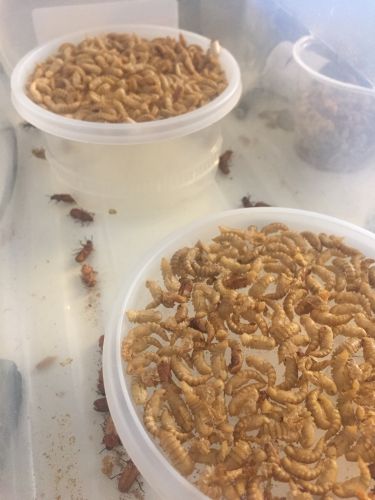
Beetles
I used to keep beetles in bins with bedding, treating just like the mealworm larvae, and that worked great! Until I got tired of how much I was sifting the beetles into new bins to ensure they wouldn’t eat all their eggs. I eventually switched over to a “self sorting” method and have been doing well with it since it’s less work.
The self sorting bins are just totes with their bottoms cut out and some fiberglass window screen hot glued to the edges. I use some wood scraps to press it all together and it’s all held together with hot glue. Which was easy, but I have had the hot glue fail since it doesn’t like to stick to plastic very well. If you want to try this, I recommend the method where you screw it all together. I’m not likely to bother any time soon, but it’s probably in my future after I found a bunch of beetles had gotten into the bottom tray after the glue separated in one corner of one of my bins.
When I had the beetles directly in bedding, I used the same bran meal that I use for the mealworms. However, with self-sorting bins, you really have to use oatmeal so it doesn’t fall through the mesh. I have found the beetles will eat the oatmeal and over time it will need to be replenished.
Additionally, I figured out quickly that the self-sorting bins need a little dusting of bedding on the floor to prevent eggs from sticking to the tote. I put just enough to ensure the eggs don’t stick; the babies don’t need much bedding until they get bigger and I’m removing them every once in a while to a nursery bin so I just don’t need much bedding on the floor.
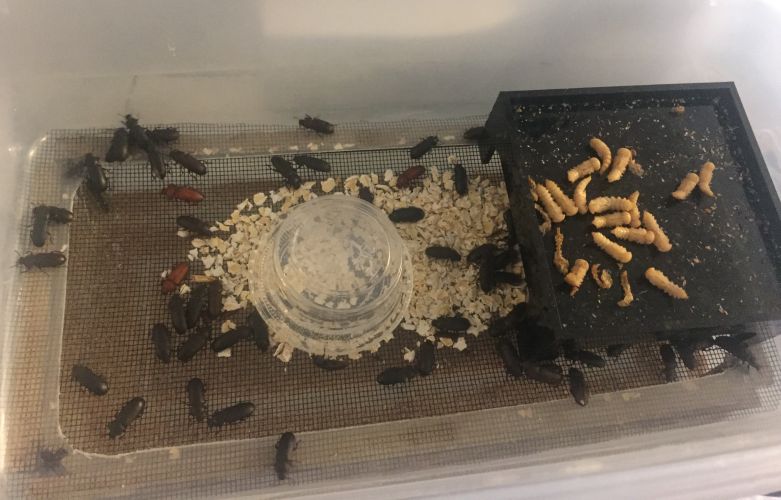
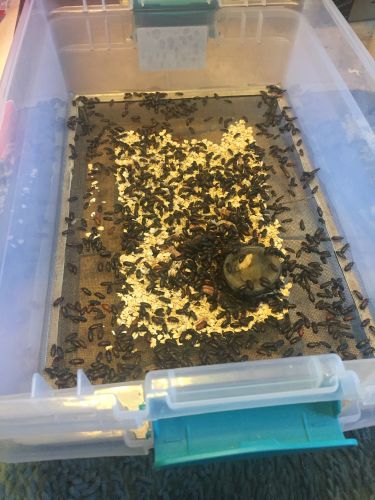
Beetle Watering
I recently have been experimenting with different ways of “watering” the beetles because using food as a water source has been inefficient and I believe the beetles simply aren’t getting enough water. It also required a lot of my attention which as my beetle population grew became harder to deal with. My new water sources have been a huge success. I only need to refill them about once every week and the beetles always have enough water.
I have two methods of beetle waterers, one is a simple gravity fed waterer, where I cut a small piece out of a 2oz portion cup, fill it with water, and set it in, upside down. It makes kind of a beetle trough, and it’s shallow enough the beetles do well with it. However, it’s risky since if it tips for any reason, it’s going to drain. I soaked some of my egg-filled bedding once with this and while I’m still using the design, it’s only in places where the bin isn’t likely to ever be disturbed.
My second design uses a cloth wick. I again took a 2oz portion cup and this time I cut two slits in the lid with a razor and I fed a small strip of terrycloth (bamboo terrycloth but only because I had scraps of it on hand already) down each slit. I wet the cloth thoroughly and filled the portion cup with water. The water wicks up the cloth as the beetles drink and slowly empties out the base. The disadvantage to this design is I had to add additional cloth on the outside to allow the beetles to climb up to the water. I used some scrap organza and a rubber band to make a climbing surface and cut a little hole to ensure they could get directly to the water cloth. It’s a popular cloth. That they like to hang out on. And lay eggs on (sigh). BUT! If it tips over, nothing drips out. Safe! I’ve even left one on its side on purpose to make it easier for the beetles to climb up.

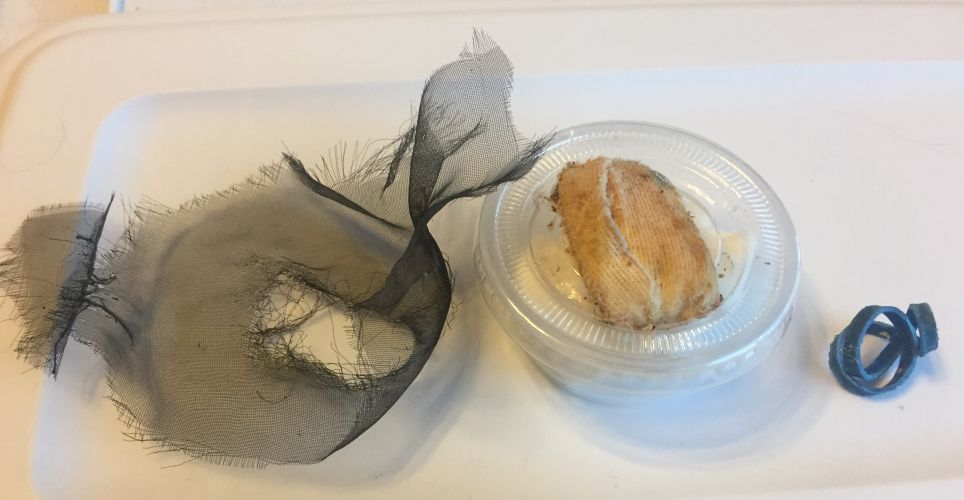

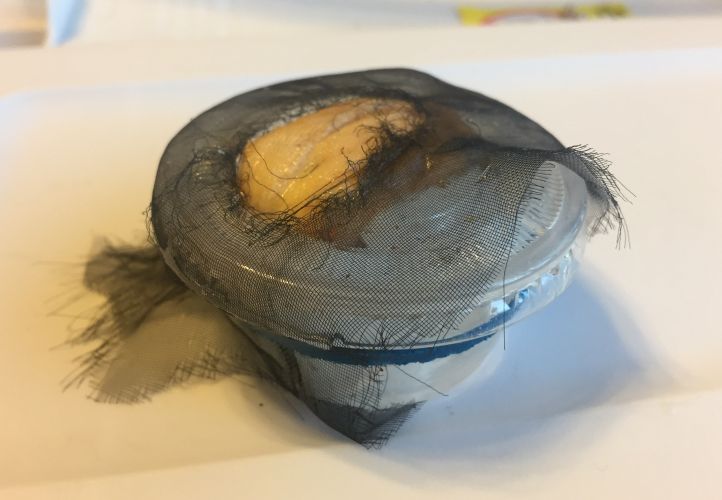
Nursery Bins
I pull bedding from the bottom of the self-sorting beetle bins whenever I feel like it (once a month or two? Maybe? Whenever.) and keep the nursery bins separately for amount a month or two before integrating the babies into my tower. I use a spray bottle of water to provide liquid to the babies about once a week until they’re large enough to bother feeding properly.
